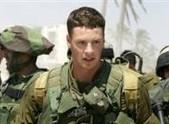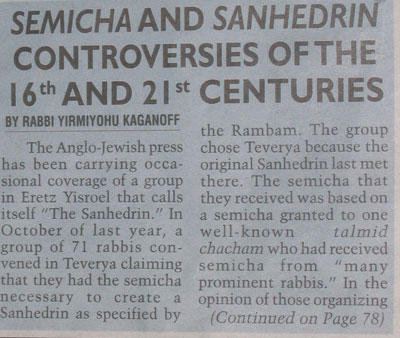From Arutz-7:Rabbi Adin Even-Israel Steinsaltz Elected to Head Sanhedrin21:55 Jun 06, '05 / 28 Iyar 5765
As parades filled the streets of Jerusalem Monday - Jerusalem Day - the reestablished Sanhedrin convened in the city to elect a Nassi and representatives to lead it.
The Sanhedrin was reestablished last October in Tiberias, the place of its last meeting 1,600 years ago. Since then, it has met in Jerusalem on a monthly basis, various committees meeting more often to discuss issues ranging from the areas of the Temple Mount permitted to Jewish worshipper by Jewish law, to the establishment of courts of non-Jews who accept the Seven Laws of Noah and to Prime Minister Ariel Sharon's plan to uproot the Jewish communities of Gaza and northern Samaria.
Semicha - original rabbinic ordination - was successfully reintroduced when hundreds of Israel's rabbis agreed on the worthiness of a certain rabbi to serve on the Sanhedrin. This was also agreed upon by leading Sephardic and Ashkenazic spiritual leaders Rabbi Ovadia Yosef and Rabbi Shalom Elyashiv. This fulfilled the Jewish legal requirements as outlined by Maimonides.
The rabbi himself eventually backed down from serving as Nassi of the Sanhedrin due to pressure from a leading Hassidic rabbi, but not before granting semicha to Rabbi Tzvi Idan, who granted semicha to the 71 other members of the body and served as its temporary Nassi.
Since the current Sanhedrin's launch, it has been in a transitional stage as it gathered support and sought to rebuild the institution in accordance with Jewish law. A temporary Nassi was appointed, but the mandated period came to an end, so it was decided at the court's last meeting that as the Sanhedrin strengthens, it must become autonomous from the original founding committee and elect its own officials.
Due to concerns regarding external pressure upon individuals not to take part in the establishment of the institution of a Sanhedrin, the names of most participants have been withheld up to this point, upon the request of the Sanhedrin's spokesmen.
The court of 71 rabbis has now decided to select of a group of seven individuals within the Sanhedrin to represent the institution in dealings with the public and with Gedolei Yisrael - recognized spiritual leaders of Israel.
Arutz-7's Ezra HaLevi was at Monday's Sanhedrin meeting, where it was decided to release the names for purposes of transparency as well. It was concluded that the Sanhedrin has become strong enough for its members to be able to withstand criticism, particularly of the "what makes you think you are worthy of sitting on it?" nature. In that vein, it is hoped that the release of the seven names will encourage those who believe that their own rabbis or teachers have something to contribute to the endeavor, to get involved in the monumental task that still lays before the judicial body.
Monday, those present (a minimum quorum of 23 Sanhedrin members is necessary for a vote to take place) chose seven names from a list of nominees to represent the Sanhedrin to the Jewish world and to spiritual leaders.
Rabbi Adin Even-Israel (Steinsaltz) received the most votes of confidence in his ability to lead the Sanhedrin through the next stage of its development.
The six others who were chosen by the Sanhedrin were:
Rabbi Nachman Kahane - Rabbi of the Young Israel of Jerusalem's Old City and head of the Institute for Talmudic Commentaries, which is involved in the study of the Temple rituals and ceremonies, as well as cataloging of all known kohanim (priests) in Israel. He is the brother of murdered Knesset Member, Rabbi Meir Kahane.
Rabbi Yisrael Ariel - One of the paratroopers who took part in the 1967 liberation of the Temple Mount, a former Yeshiva head and founder of the Temple Institute in Jerusalem, which has produced many of the vessels to be used in the Third Temple.
Rabbi Yoel Shwartz - Founder and rabbi of the "Nachal Haredi" IDF unit specifically designed to enable the hareidi-religious public to join the IDF, a teacher at Yeshivat Dvar Yerushalayim and author of approximately 200 books on Jewish law and theology, including influential guides for gentiles seeking to serve G-d and observe the Seven Laws of Noah.
Rabbi Dov Stein - The secretary of the Sanhedrin since its inception, dealing with logistical aspects as well as interacting with recognized Torah scholars and inviting rabbis to join the body.
Rabbi Yehuda Edri - A prime initiator of the re-establishment of the Sanhedrin, an accomplished author and leader of the Movement for the Rebuilding of the Temple.
Rabbi Dov Levanoni - An elder Chabad-Lubavitch rabbi and expert on the Holy Temple.
Rabbi Steinsaltz was reluctant to accept the position of Nassi, saying there are much wiser and more capable people among the group and among the Jewish people. "The purpose of the Sanhedrin is to bring unity to the nation." Steinsaltz said, speaking about the unique nature of Jerusalem to bring the Jewish people together. He claimed that there must be someone less "controversial" than himself for the position.
"The fact that he is not chasing after the honor of the position is exactly what makes him the best one for the job," another Sanhedrin member told those present.
"We are not offering honor, though," said Rabbi Yisrael Ariel. "We are offering the ability to fulfill a mitzvah (Divine commandment) that for 2,000 years was unavailable."
Steinsaltz then said that the position of Nassi was not something that could simply be accepted on the spot, hinting that it was only fitting for the head of the Sanhedrin to shun the title repeatedly until coerced. "If someone is supposed to refuse three times when asked to be on the Sanhedrin, then how much more should he be reluctant to take the mantle of Nassi," Steinsaltz said.
Rabbi Steinsaltz is regarded as one of the world's leading scholars and rabbis. He holds a degree in mathematics from the Hebrew University in addition to his extensive Torah study. At the age of 23, he became Israel's youngest high school principal and went on to found the Israel Institute for Talmudic Publications. He has published to date 58 books on the Talmud, Jewish mysticism, religious thought, sociology, historical biography, and philosophy. These books have been translated into Russian, English, French, Portuguese, Swedish, Japanese, and Dutch. His commentary on Pirkei Avot, the Chapters of the Fathers, was translated into Chinese and published in 1996. Rabbi Steinsaltz is best known for his interpretation, commentaries, and translations of the Babylonian Talmud, a task which he began some 25 years ago.
In Israel, Rabbi Steinsaltz is the Dean of the Mekor Chaim of Jerusalem network of schools, which encompasses kindergarten through high school. In 1988, Rabbi Steinsaltz received the Israel Prize, the country's highest honor. Rabbi Steinsaltz is also very involved in the future of the Jews in the former Soviet Union, traveling there once a month and setting up various educational institution for Jews still living there.
Newsweek magazine said of the Nassi-elect: "Jewish lore is filled with tales of formidable rabbis. Probably none living today can compare in genius and influence to Adin Steinsaltz, whose extraordinary gifts as scholar, teacher, scientist, writer, mystic and social critic have attracted disciples from all factions of Israeli society."
Also present, though not seated around 71-seat semi-circular row of chairs was famed archaeologist Dr. Vendyl Jones, who is working with the Sanhedrin to establish a system of courts for non-Jews adhering to the Seven Laws of Noah, which are obligatory upon all of humanity. One of those laws is to establish courts of justice. A high court has been established by the Sanhedrin for such purposes and a subsidiary of that court will soon be established in the United States as well.
Among the many topics the Sanhedrin intends to address are the bridging of the divisions between various communities of Jewish exiles who have returned to Israel; the establishment of authentic techeilet, the biblical blue thread Jews are commanded to wear amongst the fringes attached to four-cornered garments; the definition of the measurement of the "ammah" (the biblical "cubit"); the determination of the exact point of human death, so as to deal with the Jewish ethics of euthanasia; and the issue of agunot - women whose husbands refuse to grant them a divorce.
Those currently sitting on the Sanhedrin stress that each one of them assumed their seats on condition that they be prepared to give them up to anyone greater in wisdom who joins. Those interested in becoming involved with the Sanhedrin should contact the Sanhedrin secretariat at: 02-566-1962 (972-2-566-1962 from outside Israel)
 Is Avi - Sharon's Worst nightmare Come True?
Is Avi - Sharon's Worst nightmare Come True?
 (AP)
(AP)

 (Reuters)
(Reuters) (AP)
(AP)








